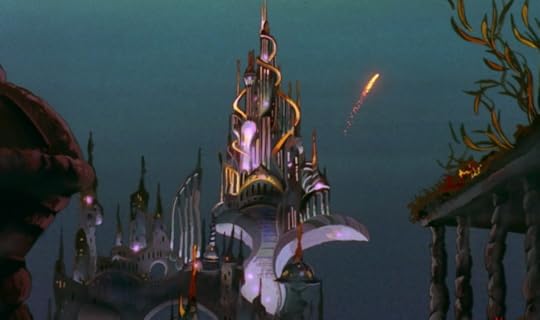The Little Mermaid, The Series: The Evil Manta
Wha’ Happen’?
Things get off to a bad start right away when The Little Mermaid the series violates the unwritten rule that all Disney series from the nineties have to have an absolute banger as a theme song. Instead, TLM has a wordless medley of the themes for Under the Sea and Part of Your World. Fantastic pieces of music no doubt, but it still feels more than a little lazy.
Anyway, remember the Under the Sea sequence from the original movie? Sure ya do. Well, it turns out that’s just how life is in Atlantica all the time, a never-ending calypso-infused bacchanal under the kindly patrician gaze of beloved despot King Triton. So Triton and Sebastien are taking a trip see the “turtle races” and Ariel and Flounder take the opportunity to go exploring. Near a sinister looking volcano they hear a weak, pathetic voice begging them for help and discover an unseen creature trapped in the volcano’s crater. Ariel wants to help but Flounder reminds her of the legend of a terrible monster that was trapped in a volcano (much like this one actually) by the ancient Atlanticans and that would certainly doom their entire civilization if it was ever freed. Ariel, naturally, tells Flounder not to be such a little bitch and frees the creature which turns out to be…the thing, the thing I just said.
 I’m not even going to insult you by telling you who they got to voice him. You should be able to tell just by looking at him.
I’m not even going to insult you by telling you who they got to voice him. You should be able to tell just by looking at him. This is the Evil Manta and he is far and away the best thing in this episode and the series itself. Great vocal performance and a magnificent design based on an earlier concept for Ursula.

The Manta thanks Ariel for freeing him and soars off towards Atlantica like a Fellbeast of the sea. And how does he propose to bring about the doom of the Ocean Kingdom? With Mean Girls Bullshit.
Seriously, his plan is to go to each sea critter in Atlantica (individually) and tell them how they are so much better than all the other fish. Pretty soon Atlantica’s peaceful multi-ethnic monarchy has become riven with factionalism and sectarian strife in a startlingly accurate depiction of the last days of the Austro-Hungarian Empire. Pretty soon the octopuses are fencing off their octo-territory, the sword-fishes are sharpening their blades and the goldfish are presumably dying because they are a freshwater species but until that day comes they are ready for war.
Ariel and Flounder hurry back to the city to try and stop him. Flounder gets caught and hypnotised by the Manta and Ariel thinks that he’s been turned against her but fortunately the power of friendship makes him immune to Manta’s power. We then get a flashback to how Ariel and Flounder first met because finding enough plot to fill twenty minutes is really hard.

Ariel manages to defuse the impending race war by singing a song about the joys of multiculturalism (the Rodney King riots were ended the same way, I seem to recall) and the Manta is driven off by the sheer power of music.
How was it?
From an animation perspective this is really hard to judge. On the one hand, it’s obviously leaps and bounds ahead of 90% of animation on TV screens at the time. There’s some really cool use of lighting effects too, a lot of striking imagery and some really lovely, painterly backgrounds.



But there’s really no getting around it, these character’s are just too complex to animate on a TV budget. Glen Keane’s Ariel design, one of the crowning achievements of the Renaissance, just looks subtly wrong and poor Flounder seems to spend as much time off model as on. And much as the design of Ariel has been flattened and simplified, so too her character. There’s none of the anger and emotional turbulence that made her such an instantly iconic and appealing figure in the original film. Here she’s pretty much what you picture when you hear the words “Disney Princess”. She teaches some animals about loving each other and being friends with a song for fuck’s sake. That’s bordering on self-parody.
The moral of the story is: Racism is caused by one guy going around talking shit.
Does this violate continuity?: If you are, like me, one of those poor wretches who actually cares about the narrative consistency of the Little Mermaid franchise be at peace. This doesn’t clash with the original movie. It does contradict the first meeting of Ariel and Flounder depicted in Little Mermaid 3 but that movie came later so that was violating the canon already established by this episode. I am 38 years old.



